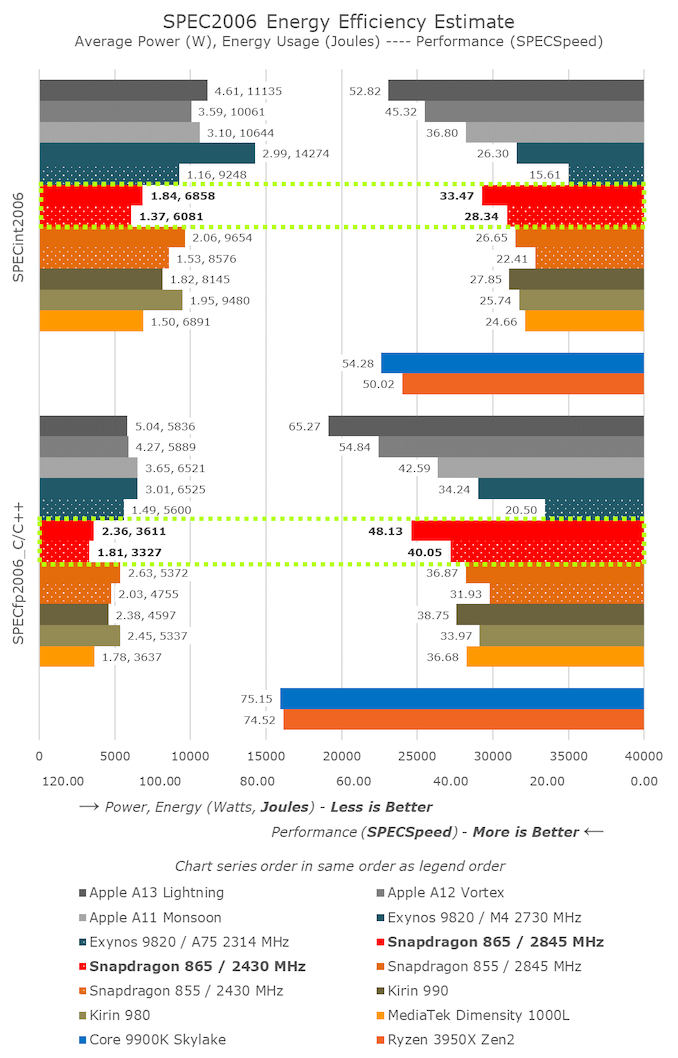
Original Link: https://www.anandtech.com/show/15609/samsung-galaxy-s20-ultra-snapdragon-865-quick-performance-preview
Samsung Galaxy S20 Ultra (Snapdragon 865) Quick Performance Preview: Impressive
by Andrei Frumusanu on March 13, 2020 6:00 AM EST- Posted in
- Samsung
- Smartphones
- Mobile
- Galaxy S20
- Galaxy S20 Ultra
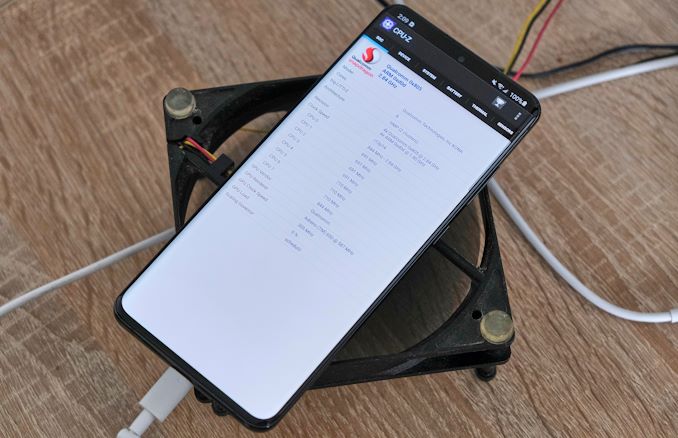
Samsung's Galaxy S20 series phones have been available since last Friday in markets such as the US. And earlier this week we also finally received a unit, in the form of a North American, Snapdragon 865-based Galaxy S20 Ultra. While our review is already underway, we’re also still waiting for public availability in Europe in order to get our hands on our Rest of World, Exynos 990 variant, so that we can take a comprehensive look at both variants of the S20 series. As we've seen in previous years, there have been some pretty significant differences between the Snapdragon and Exynos models at times, thanks to the SoC selection impacting everything from performance to image processing.
But first things first: since we have a bit of a lead time with the Snapdragon unit, we wanted to at least publish the performance figures for this model ahead of the full review, to temporarily satisfy everyone’s curiosity on at least this aspect of the phone.
Read More:
-
The Snapdragon 865 Performance Preview: Setting the Stage for Flagship Android 2020
-
Samsung Announces The Galaxy S20, S20+ and S20 Ultra: 120Hz, 5G, Huge Batteries, Crazy Cameras and $$$
System Performance
System performance of the new Galaxy S20 Ultra is an interesting topic, as there are several new aspects to this year’s flagship phone. The one big difference that trumps every other addition is the fact that Samsung has been able to integrate a new 120Hz refresh rate display. This change alone puts the new S20 series far ahead of other mainstream phones in the market, and the new experience is fantastic.
Besides the new higher refresh rate screen, we’re also naturally seeing the upgrade to newer generation SoCs. In this first instance, we’re testing the Snapdragon 865 variant of the Galaxy S20 Ultra. For their latest flagship SoC, Qualcomm adopted the new Cortex-A77 CPU cores, promising to bring 20-25% higher performance over its predecessor.
Finally, we do have to remember that Samsung has a “performance” feature in its battery settings, which increases the aggressiveness of the scheduler to fully unlock the performance of the phone. Usually we test Samsung phones with this option enabled, both in our performance as well as battery life testing.
Starting off with our usual system performance tests, these evaluations are highly sensitive to the responsiveness of the phone, which is tied to the aggressiveness of the DVFS and scheduler of the CPUs. For the Galaxy S20 Ultra, we have four score combinations, showcasing the 60 and 120Hz modes, as well as the “High Performance” mode on or off.
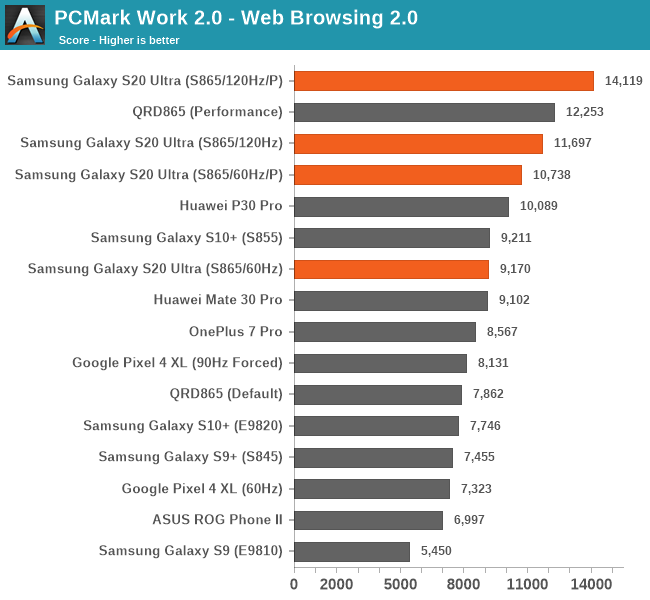
The web browsing test in PCMark is quite sensitive to performance responsiveness, and in this regard, the new Snapdragon 865 doesn’t disappoint. Switching between the 60 and 120Hz modes, we see a notable increase in fluidity, and this is picked up by the benchmark.
At the highest performing settings, the new Galaxy S20 Ultra even outperforms the QRD865 platform that we tested back in December. This was quite surprising, as I wasn't expecting commercial devices to ship with as aggressive settings as that phone’s “Performance Mode”, which did seem tad aggressive.
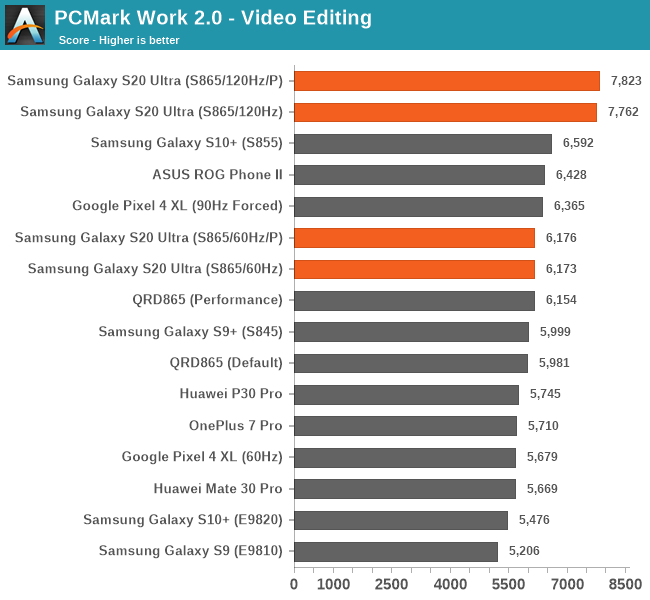
The video editing test has largely lost its performance scaling usefulness, but still is able to pick up the new 120Hz mode of the S20U, representing a jump ahead of any other phone in the market.
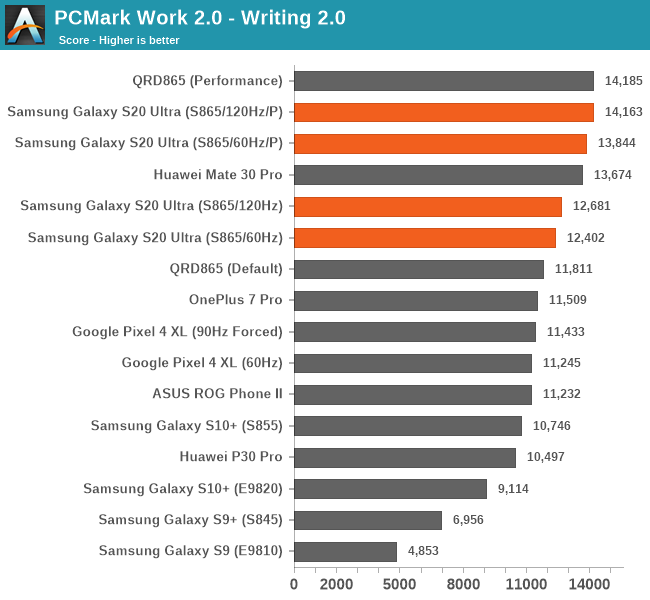
The writing sub-test is very important in terms of being a representation of every-day snappiness of a phone, and the Galaxy S20 Ultra here tops the charts, falling in line with the best scores from the QRD865 as well as now slightly leaping ahead of Huawei’s Mate 30 Pro.
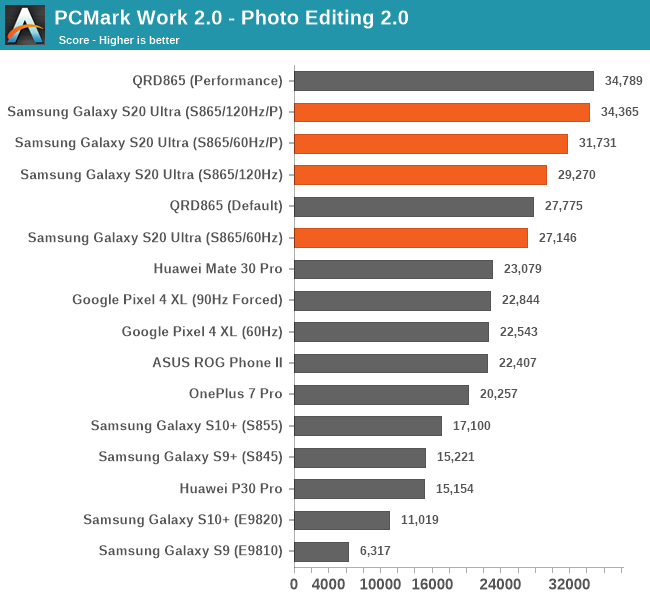
The photo editing test similarly is scaling up in performance across the different setting configurations, showcasing fantastic performance.
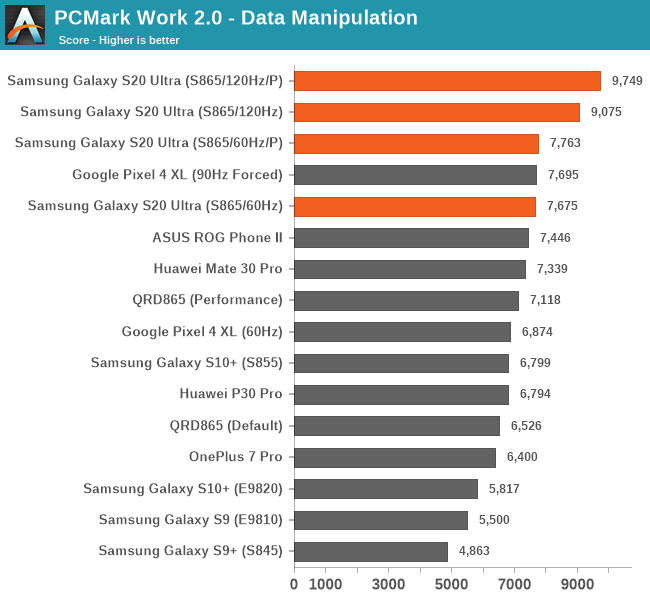
The data manipulation score also seemingly is tied to the framerate achieved during the test, and the 120Hz mode of the S20U leads all other devices.
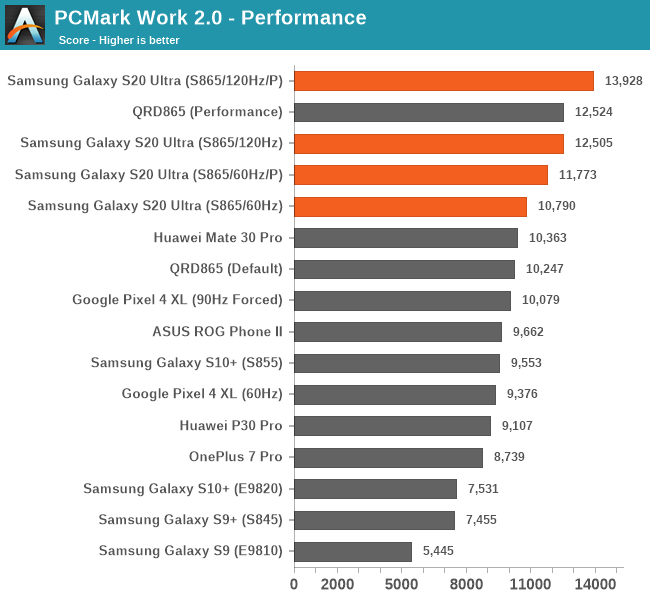
In the overall results, no matter what setting you’re using, the Galaxy S20 Ultra with the Snapdragon 865 tops all other commercially available Android phones out there, and at its peak settings, it even outperforms the QRD865 in its aggressive performance mode.
I did some quick testing of the DVFS aggressiveness between the optimized and performance modes, and was surprised to see no difference in the resulting scaling behavior. This means that the performance differences must arrive from the overall more aggressive scheduling, rather than scaling up to higher frequencies sooner. We’ll go over this aspect in more detail in the full review.
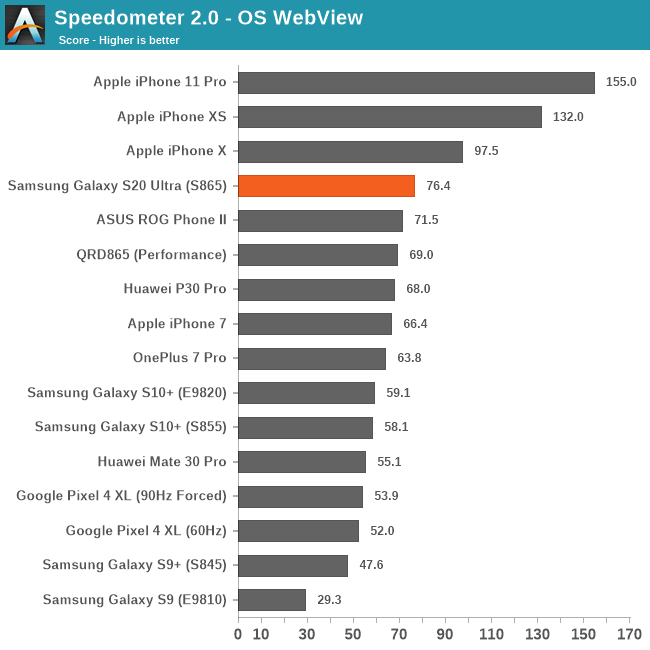
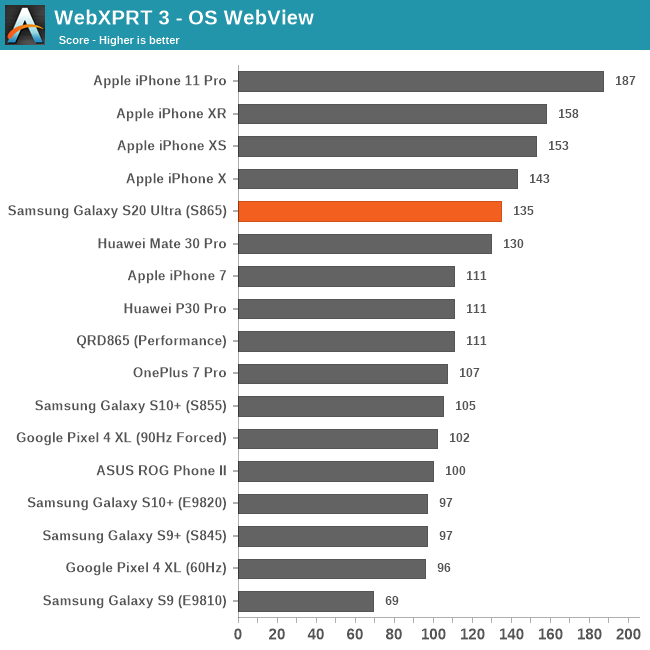
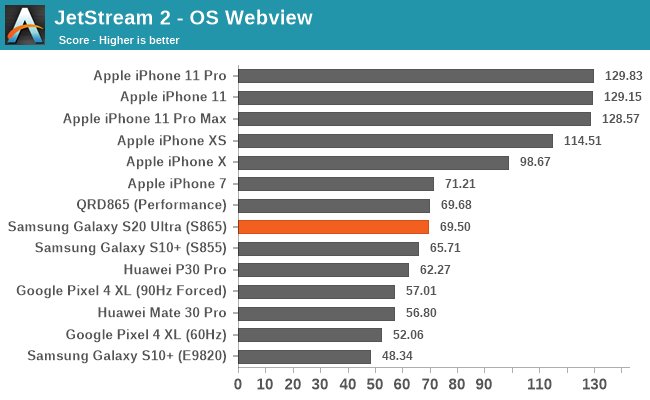
In all our three web tests, we see the S20 Ultra in line with what the QRD865 was able to achieve, with some slight leads in WebXPRT 3. The Cortex-A77 seemingly doesn’t improve its instruction throughput very much in high instruction pressure heavy workloads such as the web-based JS benchmarks, so that’s possibly why we aren’t seeing that large increases here.
CPU Performance & Power
Our power testing back in December on the QRD865 platform wasn't quite as accurate as I would have hoped for, as the phone's power management funcitonality as well PMIC calibration weren’t quite polished. I had opted to publish numbers on the more pessimistic side of the scale, and I’m glad I did as it does turn out that the new chipset performs quite a bit better in actual commercial devices, including of course the S20 Ultra.
These new figures mean that the Snapdragon 865 actually does not behave as expected – we had been anticipating it requiring more power to achieve its higher performance points – and instead Qualcomm has managed to reduce absolute power all while increasing the performance. As a result, we’re seeing a much larger generational improvement in the energy efficiency of the chip. The new “middle” cores of the Snapdragon 865 also outperform the performance cores of the Snapdragon 855, and that does signify for quite a large multi-threaded performance boost.
We’ll be going over the detailed results as well as include an analysis of the Exynos 990 chip in our full review, but for now, it seems that the Snapdragon 865 is an excellent chipset, and will serve as a great base for 2020 devices.
GPU Performance & Power
We also finished up our GPU testing for the Galaxy S20 Ultra, and are able to showcase the Snapdragon 865’s true power efficiency as well as long-term performance for the first time.
The new Adreno 650 iGPU is a continuation of the architecture that has powered Qualcomm’s last two generations of SoCs. The company is advertising a 25% boost in performance, which we were able to verify in our performance preview of the SoC. What wasn’t very clear back then was the power efficiency of the new chip – again, our figures on the QRD865 weren’t very accurate – so testing out the new chip on an actual commercial device will be a much more representative measurement.
This is also the first time we’re able to showcase the sustained performance figures of the new generation SoC. Qualcomm had put a lot of emphasis on this aspect of the new chip, claiming it’s able to throttle a lot less than some other competing devices in the market. We hadn’t had the time to test this on the QRD865, so the S20 Ultra here will be the first device of 2020 going through this test. As a reminder, sustained performance not only is linked to the power consumption of the SoC, but also the thermal dissipation capabilities of the phone that it’s employed in, as well as the thermal limits imposed by the vendor.
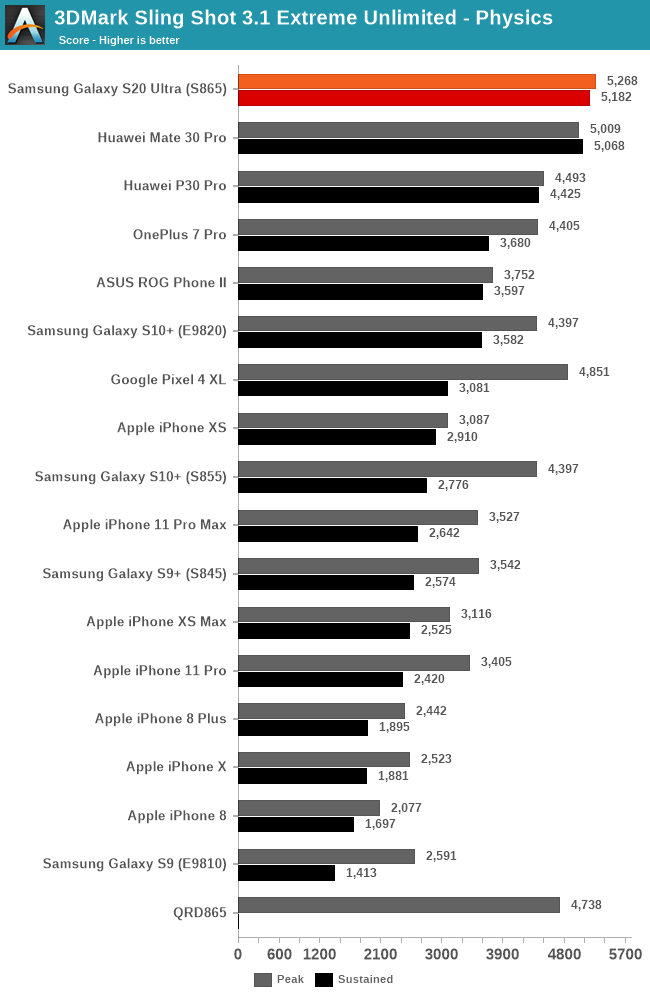
Starting off with the 3DMark Physics test, the new chip behaves fantastically, and even manages to perform better than the QRD865. The new Cortex-A77 cores are doing extremely well, and most interestingly, the sustained performance showcased by the unit is also excellent.
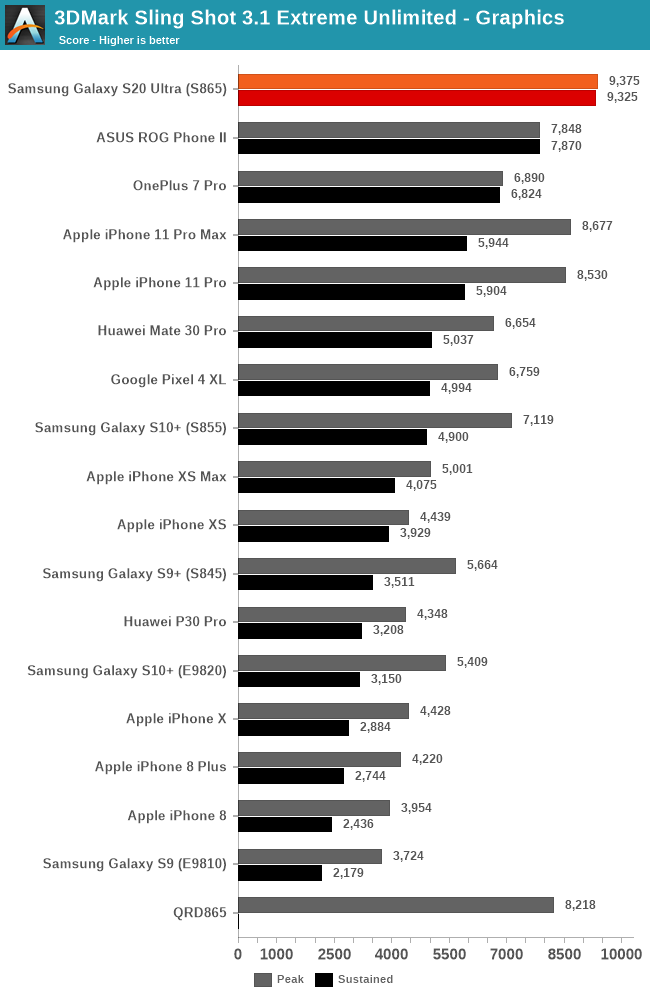
The graphics test of 3DMark is more GPU bound – and here again it showcased no throttling. This was a bit odd in the context that I did see more significant throttling in GFXBench…
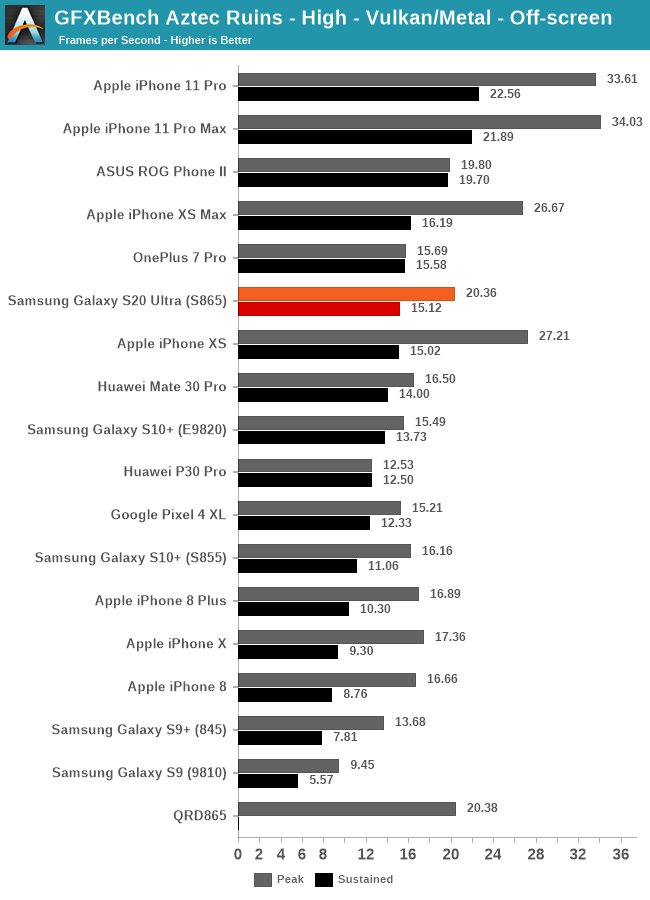
In the Aztec High test, peak performance is identical to what we’ve seen on the QRD865, and sustained performance after a while throttles down by 25%. Although it’s a good showcase, the new Galaxy S20 Ultra here doesn’t fare any better than some of the best Snapdragon 855 devices out there, as well as lagging behind Apple’s iPhones.
| GFXBench Aztec High Offscreen Power Efficiency (System Active Power) |
||||
| Mfc. Process | FPS | Avg. Power (W) |
Perf/W Efficiency |
|
| iPhone 11 Pro (A13) Warm | N7P | 26.14 | 3.83 | 6.82 fps/W |
| iPhone 11 Pro (A13) Cold / Peak | N7P | 34.00 | 6.21 | 5.47 fps/W |
| Galaxy S20 Ultra (Snapdragon 865) | N7P | 20.35 | 3.91 | 5.19 fps/W |
| iPhone XS (A12) Warm | N7 | 19.32 | 3.81 | 5.07 fps/W |
| iPhone XS (A12) Cold / Peak | N7 | 26.59 | 5.56 | 4.78 fps/W |
| Mate 30 Pro (Kirin 990 4G) | N7 | 16.50 | 3.96 | 4.16 fps/W |
| Galaxy 10+ (Snapdragon 855) | N7 | 16.17 | 4.69 | 3.44 fps/W |
| Galaxy 10+ (Exynos 9820) | 8LPP | 15.59 | 4.80 | 3.24 fps/W |
Doing power measurements on the S20U, we see quite better figures than experienced on the QRD865. Thus, the Snapdragon 865 moves up in the efficiency scoreboard, inching closer to Apple’s A-series chipsets.
What’s interesting to see here is the absolute power figure itself coming in a little under 4W. This is an excellent improvement and reduction compared to the Snapdragon 855 last year, and it means heat generation should be a lot more in check compared to previous generation flagships.
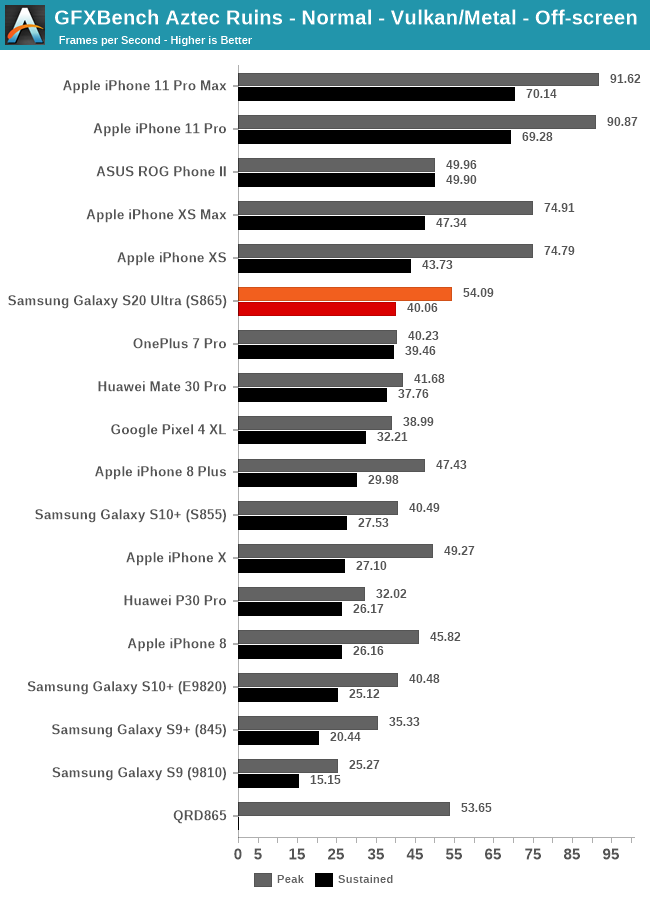
| GFXBench Aztec Normal Offscreen Power Efficiency (System Active Power) |
||||
| Mfc. Process | FPS | Avg. Power (W) |
Perf/W Efficiency |
|
| iPhone 11 Pro (A13) Warm | N7P | 73.27 | 4.07 | 18.00 fps/W |
| iPhone 11 Pro (A13) Cold / Peak | N7P | 91.62 | 6.08 | 15.06 fps/W |
| iPhone XS (A12) Warm | N7 | 55.70 | 3.88 | 14.35 fps/W |
| Galaxy S20 Ultra (Snapdragon 865) | N7P | 54.09 | 3.91 | 13.75 fps/W |
| iPhone XS (A12) Cold / Peak | N7 | 76.00 | 5.59 | 13.59 fps/W |
| Mate 30 Pro (Kirin 990 4G) | N7 | 41.68 | 4.01 | 10.39 fps/W |
| Galaxy 10+ (Snapdragon 855) | N7 | 40.63 | 4.14 | 9.81 fps/W |
| Galaxy 10+ (Exynos 9820) | 8LPP | 40.18 | 4.62 | 8.69 fps/W |
The Aztec Normal test also shows excellent absolute peak power figures, and peak performance is where it’s expected to be at. Meanwhile, throttling on the S20 Ultra is again at around -25% of peak performance for sustained scenarios.
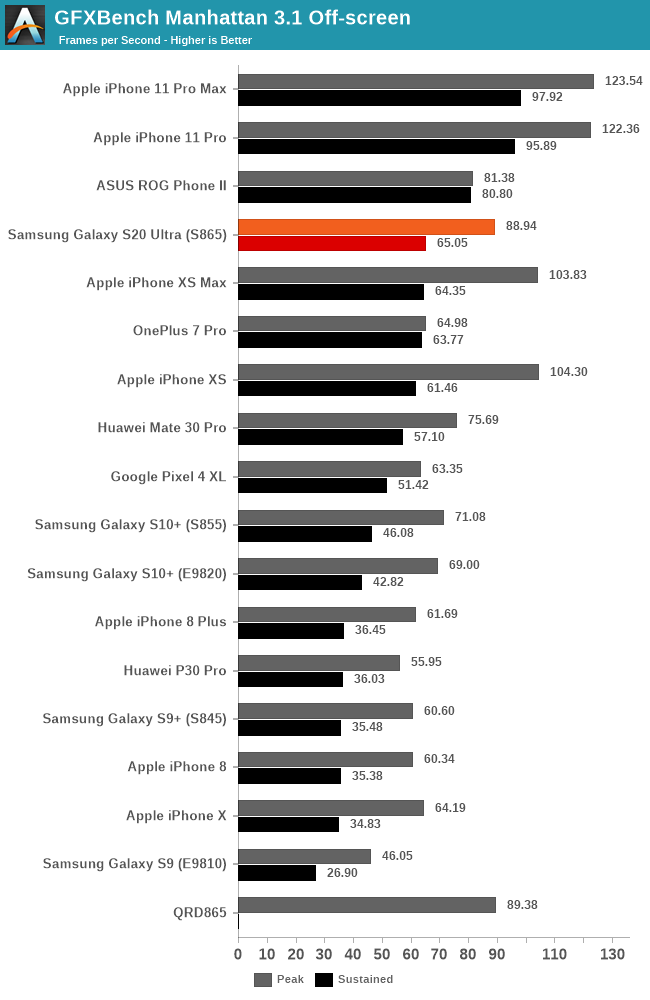
| GFXBench Manhattan 3.1 Offscreen Power Efficiency (System Active Power) |
||||
| Mfc. Process | FPS | Avg. Power (W) |
Perf/W Efficiency |
|
| iPhone 11 Pro (A13) Warm | N7P | 100.58 | 4.21 | 23.89 fps/W |
| Galaxy S20 Ultra (Snapdragon 865) | N7P | 88.93 | 4.20 | 21.15 fps/W |
| iPhone 11 Pro (A13) Cold / Peak | N7P | 123.54 | 6.04 | 20.45 fps/W |
| iPhone XS (A12) Warm | N7 | 76.51 | 3.79 | 20.18 fps/W |
| iPhone XS (A12) Cold / Peak | N7 | 103.83 | 5.98 | 17.36 fps/W |
| Mate 30 Pro (Kirin 990 4G) | N7 | 75.69 | 5.04 | 15.01 fps/W |
| Galaxy 10+ (Snapdragon 855) | N7 | 70.67 | 4.88 | 14.46 fps/W |
| Galaxy 10+ (Exynos 9820) | 8LPP | 68.87 | 5.10 | 13.48 fps/W |
| Galaxy S9+ (Snapdragon 845) | 10LPP | 61.16 | 5.01 | 11.99 fps/W |
| Mate 20 Pro (Kirin 980) | N7 | 54.54 | 4.57 | 11.93 fps/W |
| Galaxy S9 (Exynos 9810) | 10LPP | 46.04 | 4.08 | 11.28 fps/W |
| Galaxy S8 (Snapdragon 835) | 10LPE | 38.90 | 3.79 | 10.26 fps/W |
| Galaxy S8 (Exynos 8895) | 10LPE | 42.49 | 7.35 | 5.78 fps/W |
In Manhattan 3.1, things are also looking better for the Snapdragon 865. The improved power figures do have it now able to leap the A12 in power efficiency. The sustained performance comes in at 73% of peak performance in our testing conditions.
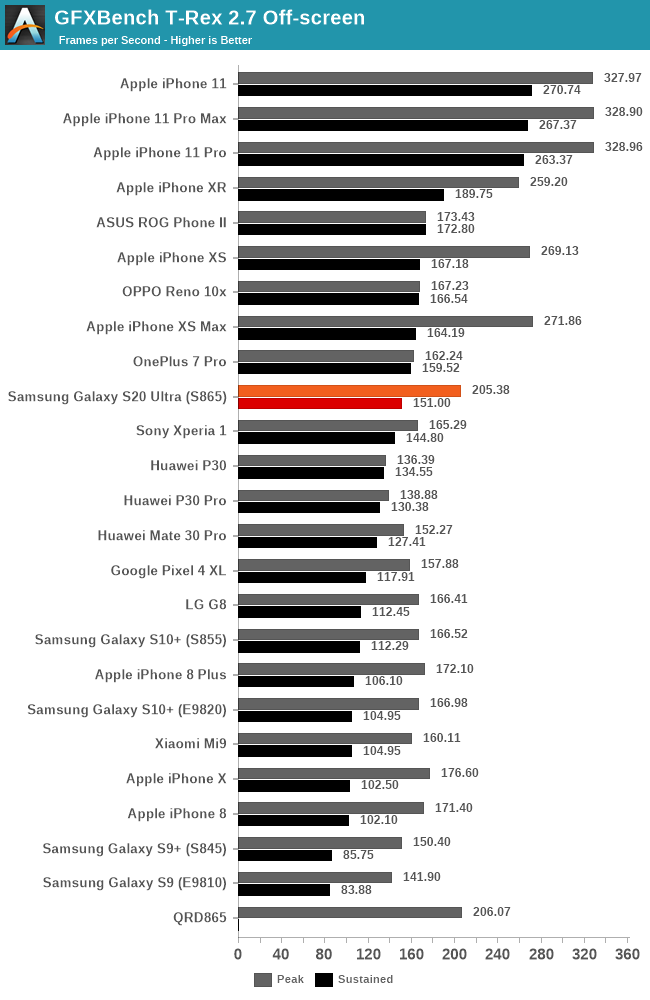
| GFXBench T-Rex Offscreen Power Efficiency (System Active Power) |
||||
| Mfc. Process | FPS | Avg. Power (W) |
Perf/W Efficiency |
|
| iPhone 11 Pro (A13) Warm | N7P | 289.03 | 4.78 | 60.46 fps/W |
| iPhone 11 Pro (A13) Cold / Peak | N7P | 328.90 | 5.93 | 55.46 fps/W |
| Galaxy S20 Ultra (Snapdragon 865) | N7P | 205.37 | 3.83 | 53.30 fps/W |
| iPhone XS (A12) Warm | N7 | 197.80 | 3.95 | 50.07 fps/W |
| iPhone XS (A12) Cold / Peak | N7 | 271.86 | 6.10 | 44.56 fps/W |
| Galaxy 10+ (Snapdragon 855) | N7 | 167.16 | 4.10 | 40.70 fps/W |
| Mate 30 Pro (Kirin 990 4G) | N7 | 152.27 | 4.34 | 35.08 fps/W |
| Galaxy S9+ (Snapdragon 845) | 10LPP | 150.40 | 4.42 | 34.00 fps/W |
| Galaxy 10+ (Exynos 9820) | 8LPP | 166.00 | 4.96 | 33.40fps/W |
| Galaxy S9 (Exynos 9810) | 10LPP | 141.91 | 4.34 | 32.67 fps/W |
| Galaxy S8 (Snapdragon 835) | 10LPE | 108.20 | 3.45 | 31.31 fps/W |
| Mate 20 Pro (Kirin 980) | N7 | 135.75 | 4.64 | 29.25 fps/W |
| Galaxy S8 (Exynos 8895) | 10LPE | 121.00 | 5.86 | 20.65 fps/W |
Finally, in T-Rex, we’re again seeing a healthy boost in efficiency compared to previous figures, but in terms of sustained performance, the S865 is still largely behind the A13 chips.
Besides the improved power efficiency numbers, we’ve now measured on the Galaxy S20 Ultra, the one thing that I really liked about the new device’s behavior is its thermal behavior. The phone wouldn’t exceed 41-42°C peak skin temperature, remaining only relatively lukewarm no matter the kind of workload you’d throw at it. This is some excellent thermal management and I appreciate this a lot more than having higher performance that leads to the phone getting uncomfortably hot. Samsung deserves some praise here.
Fantastic Performance; Stay Tuned For The Full Review
When it comes to performance, the Galaxy S20 Ultra has so far been an immensely impressive device, easily being the single fastest, most responsive, and most fluid phone I’ve had the pleasure to use, quite far ahead of any second contender. The combination of a 120Hz screen with the new Snapdragon 865 is a match made in heaven, and people prioritizing this aspect of a phone will seemingly not be disappointed in the S20 line-up.
There’s still a lot of work to do until we get the full review finished, notably still waiting on the Exynos variants of the devices. One aspect that I want to make note of right now is that there’s been some concerns in regards to the battery life aspect of the new 120Hz mode of the phones, and I can confirm that in this setting the S20 Ultra showcases worse battery life than the S10+ (-10% in our web test), even though the new unit has a more efficient SoC as well as a 21% bigger battery. Samsung’s implementation of the 120Hz mode comes at quite a large power hit that’s very disappointing in how it behaves, and the device in general seems not quite as efficient even at 60Hz.
I’ll be posting a separate battery preview once I get more battery testing numbers together, and of course we’ll have a full feature review out once all the thorough testing is completed.

